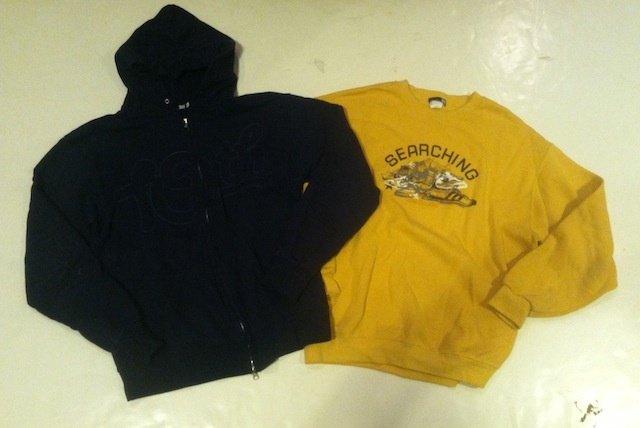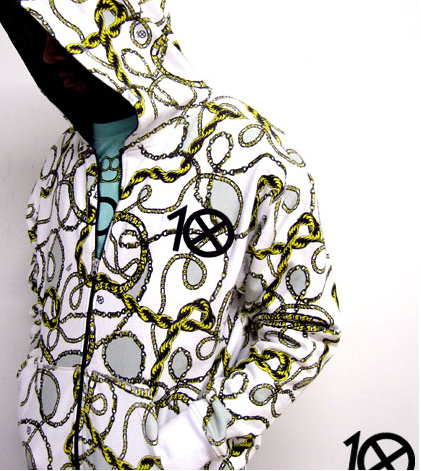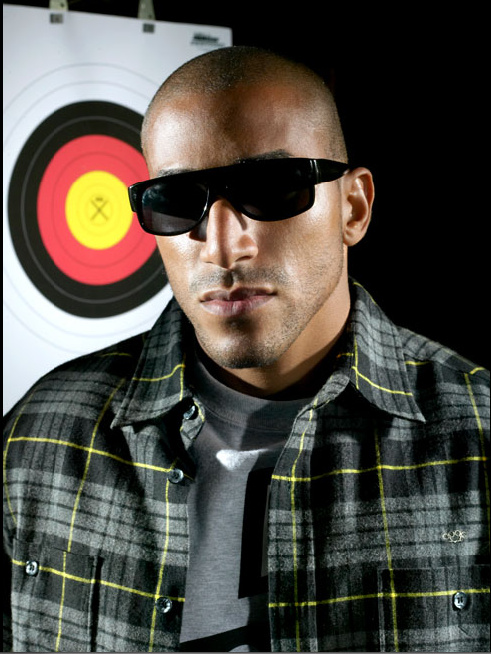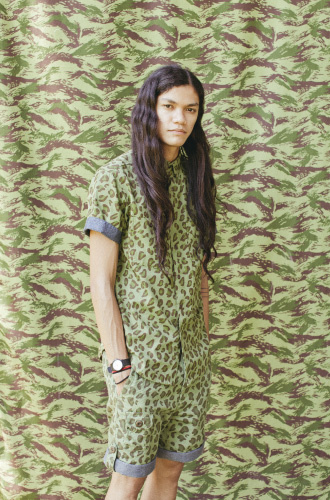
Advertisement

Advertisement

The first one I made unintentionally looked like the Champion logo, just turned it around so it looked like a D. It had a graffiti style print on the back that just said "10.Deep." I didn’t realize it looked like the Champion logo until I went to a store and tried to sell it. The person’s reaction was, "So it looks like the Champion logo. I am supposed to buy that?" I was like "Uh, it looks like the Champion logo? OK, cool."What was your first successful design?
The design that allowed 10.Deep to continue was my second set of T-shirts in ‘96, which was a series called the Urban Survival Games. I was playing with designs during the time of the Olympics and drew one of a stick figure jumping over a turnstile. That sold and really turned 10.Deep into a business. I thought, there might be something more here than just making T-shirts for my friends.So there was a growing interest in the brand at that point?
I got my first order from Japan at the end of ‘96. I had actually stopped doing 10.Deep by then. I was like, OK, that’s done. Then I got a call from someone who said, "Japanese guys want to buy your stuff and they just kept coming back for it." Those first three years ended up being all about Japan.What was your next step for moving 10.Deep forward?
The next thing I wanted to do was make a good line. At the end of ‘97, I started to think about what I was going to do to differentiate myself from other people. I started to produce some cut-and-sew items, like a pant and button down shirt. My mom was a clothing designer, so she really helped me with the patterns for the earliest cut and sew stuff. I found manufacturers in Salt Lake City because my mom moved there when I was graduating from college. She ended up being my production manager. She would go to the factory and kick ass and make sure everything was right. I am not sure if I would be here if she hadn’t helped me out early on.
Advertisement
It was funny, the first person I ever saw wearing 10.Deep wasn’t until ‘98. I ran up to this guy and I was like, "Yo, that’s my shirt!" It was a Japanese guy, who didn’t speak any English. He kind of just looked at me blankly and said "Yeah, 10.Deep." He kind of blew me off and turned back around to whatever he was doing. I was bummed. I think the next two people I saw wearing it did kind of like the same thing. To this day, when I see people wearing 10.Deep, I am not really that jazzed about it.

The first line that I created that I felt good about was fall 1999. I designed embroidered sweatshirts and it felt mature. It felt like something real. There wasn’t any particular design that was strong. But as a whole, it looked good. I think it was the season where I started to get a little bit of respect in the streetwear community. At that time, the top dog in my eyes was Ssur. I used what Russ was doing as a measuring stick for myself, and I think with that season I thought it was as good as that. Then there started to be other designs that were successful that started to propel the brand.

The high point before the market crashed was like 2000 and the beginning of 2001. I was just trying to hold on and make sure I didn’t have to shut the brand down after that. I think in 2002 we started to do the business that we had been doing before. 2001 was just horrible. in 2002, I had a couple of winners. I did this Problem Solvers tee that was kind of big for the brand. It was just an image of brass knuckles with the words PROBLEMS SOLVERS above it and ALL WRONGS RIGHTED beneath it. It helped define the brand for a lot of people, but it was a joke to me. I am not a tough guy. It kind of took over all of the other stuff that I was doing for the brand. The next thing I knew, the knuckles were my logo and I was like, I don’t know if I want this to be a logo for the brand.
Advertisement
There was another T-shirt too with a gasmask. Both of those tees I sold like 500 units. Where as prior, my best tee would sell like 300. In that season—spring/ summer 2002—it felt like the brand started to be successful. It started to be financially rewarding also.Once the brand became profitable, how did life change for you?
Well I quit my job in 2004. I was working at an urban brand that I helped some of my friends start. I just got totally fucking bored with it. I figured I had enough of that. I had never really planned on being a designer. I thought I was going to go back to school or build a portfolio of my work to bring to galleries and just do 10.Deep on the side, but 10.Deep ended up taking over. I got the office in this building in 2004.So were you ready to commit to 10.Deep at that point?
At the end of 2005, I was ready to be done with it again. I drew the lines in the sand. I told josh and another guy working with me at the time, "If we don’t do this much in sales this season, we are done." I had burned through all the money I had saved from my other job through all the years of doing 10.Deep.

The chain gang sweatshirt, which was another joke to me. I didn’t think anyone would take it seriously. Josh had gone to a tradeshow and we had the sweatshirt there, in February of ‘06. We had 300 in the company and we got orders for 4,000 of them. He called me and he was like, "I think things just changed." That was the big one, because I was ready to be done with it.
Advertisement
When I think of all of the misreadings of some of the bigger designs we have done, I think of the chain gang print. People think that it’s about wealth in a positive way, where it is kind of glorifying it. To me, it was just a joke. I am not a person who takes myself seriously. It is the same thing with the Problem Solvers graphic. That was a joke, but I see guys wearing the shirt trying to be extra tough. I am like, really? That is not what it is about. You put things out there and it becomes what people want it to be. You think I would have figured this shit out by now…What are some of the challenges you have faced with the brand?
All those years early on, my struggle was trying to sell the brand. People would say, is this a black urban brand or is this a skate brand? I was like, "It’s neither, it is all that shit." 10.Deep is just youth culture. Nobody got it and then the streetwear thing blew up and to me that’s what it was about. Now what that was has been turned on its head and now streetwear is urban again. I am totally confused about what it is, honestly. I get people that come up to me now like, "Oh this is an urban brand." I am like, "No, this is just a whatever brand." It is about togetherness.How have kept the brand relevant for almost 20 years?
I started to focus on the cut and sew stuff and for fall of 2007, what I focused on was making nice plaids and having nice fits on the button down shirts, which nobody else was making. Everything in the market was big and wide. That is really what kept us on through the recession.
Advertisement

By 2010 I stopped even designing the T-shirts. These days, I design cut and sew stuff first with the patterns.

I was sick of streetwear trying to be plain and heritage. Everybody was trying to do everything super clean, so I decided to do the exact opposite of that and started doing the allover patterns again and the top and bottom matching thing for summer 2012. I frankly didn’t think people were going to respond positively to that at all, but I thought it was great and funny. That sort of change brought even more attention to the brand.

My favorite lines were those where there were significant changes, like summer 2012, when I first started doing the pattern matching. Maybe the Holiday Collection for this year is my favorite. This whole year I have felt like I have finally produced on a level that was up to my own standards. I didn’t even want to do 10.Deep again, that is like a constant theme in my life, but I decided if I was going to do it I was going to make product that I felt was interesting. But of all the things, what I've enjoyed the most is the excitement of the growth and getting to share that along the way.

I want to get the store finished. The store is going to be about creating a cool space. I want to open the doors of the community to the brand. I think doing that will help bring the next generation of folks into 10.Deep. But I am old now. I feel like I want to move forward and do different things for myself. The same way I have reinvented the brand, I want to reinvent myself.
